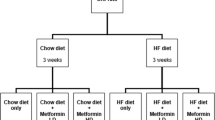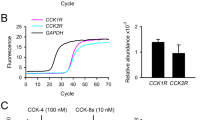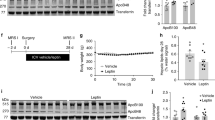Abstract
OBJECTIVE:
Leptin inhibits appetite and reduces body weight. However, subcutaneous leptin administration is not very effective on weight reduction. The present studies were undertaken to test the hypotheses that nasally administered leptin effectively accesses to the brain and inhibits appetite.
METHODS:
Recombinant leptin (0.5 mg/rat) was administered into the bilateral nasal spaces of rats (i.n.). Changes in serum immunoreactive leptin (IRL) and cerebrospinal fluid (CSF)-IRL concentrations after i.n. leptin administration were compared after intraperitoneal (i.p.) administration. The influence of 0.1 or 0.5% lysophosphatidylcholine (LPC) as an optimizer of leptin absorption was examined. The anorexic effects of i.n. leptin were compared with i.p. leptin in ad libitum fed rats.
RESULTS:
The i.n. leptin increased CSF-IRL concentrations, although serum IRL concentrations of rats administered leptin i.n. were lower than those administered i.p. The addition of 0.1 and 0.5% LPC dose-dependently increased serum IRL concentrations, but did not modify CSF-IRL concentrations in i.n. leptin-treated rats. The i.n. leptin inhibited dark-time food consumption at 0–1 h and 3–6 h in ad libitum fed rats. In contrast, i.p. leptin reduced food consumption only for an hour. Phosphorylated signal transducer and activator of transcription (STAT) 3 immunoreactive cells increased in the arcuate nucleus (ARC) of the hypothalamus at 3 h only following i.n. leptin.
CONCLUSION:
The present study demonstrated that i.n. leptin caused longer inhibition of appetite and phosphorylation of STAT3 in ARC. It is concluded that the trans-nasal route may be useful for the selective access of leptin to the brain in obese people.
This is a preview of subscription content, access via your institution
Access options
Subscribe to this journal
Receive 12 print issues and online access
$259.00 per year
only $21.58 per issue
Buy this article
- Purchase on Springer Link
- Instant access to full article PDF
Prices may be subject to local taxes which are calculated during checkout





Similar content being viewed by others
References
Zhang Y, Proenca R, Maffei M, Barone M, Leopold L, Friedman JM . Positional cloning of the mouse obese gene and its human homologue. Nature 1994; 372: 425–432.
Halaas JL, Gajiwala KS, Maffei M, Cohen SL, Chait BT, Rabinowitz D, Lallone RL, Burley SK, Friedman JM . Weight reducing effects of the plasma protein encoded by the obese gene. Science 1995; 269: 543–546.
Campfield LA, Smith FJ, Guisez Y, Devos R, Burn P . Recombinant mouse OB protein: evidence for a peripheral signal linking adiposity and central neural networks. Science 1995; 269: 546–549.
Montague CT, Farooqi IS, Whitehead JP, Soos MA, Rau H, Wareham NJ, Sewter CP, Digby JE, Mohammed SN, Hurst JA, Cheetham CH, Earley AR, Barnett AH, Prins JB, O’Rahilly S . Congenital leptin deficiency is associated with severe early-onset obesity in human. Nature 1997; 387: 903–908.
Clement K, Vaisse C, Lahlou N, Cabrol S, Pelloux V, Cassuto D, Gourmelen M, Dina C, Chambaz J, Lacorte JM, Basdevant A, Bougneres P, Lebouc Y, Froguel P, Guy-Grand B . A mutation in the human leptin receptor gene causes obesity and pituitary dysfunction. Nature 1998; 392: 398–401.
Schwartz MW, Peskind E, Raskind M, Boyko EJ, Porte Jr D . Cerebrospinal fluid leptin levels: relationship to plasma levels and adiposity in humans. Nat Med 1996; 2: 589–593.
Banks WA, Kastin AJ, Huang W, Jaspan JB, Maness LM . Leptin enters the brain by a saturable system independent of insulin. Peptides 1996; 17: 305–311.
Caro JF, Kolaczynski JW, Nyce MR, Ohannesian JP, Opentanova I, Goldman WH, Lynn RB, Zhang PL, Sinha MK, Considine RV . Decreased cerebrospinal-fluid/serum leptin ratio in obesity: a possible mechanism for leptin resistance. Lancet 1996; 348: 140–141.
Heymsfield SB, Greenberg AS, Fujioka K, Dixon RM, Kushner R, Hunt T, Lubina JA, Patane J, Self B, Hunt P, McCamish M . Recombinant leptin for weight loss in obese and lean adults. JAMA 1999; 282: 1568–1575.
Illum L . Transport of drugs from the nasal cavity to the central nervous system. Eur J Pharm Sci 2000; 11: 1–18.
Lawrence D . Intranasal delivery could be used to administer drugs directly to the brain. Lancet 2002; 359: 1674.
Hussain A, Foster T, Hirai S, Kashihara T, Batenhorst R, Jones M . Nasal absorption of propranolol in humans. J Pharm Sci 1980; 69: 1240–1242.
Gizurarson S, Thorvaldsson T, Sigurdsson P, Gunnarsson E . Selective delivery of insulin into the brain: intraolfactory absorption. Int J Pharm 1996; 140: 77–83.
Yaksh TL, Scott B, LeBel CL . Effect of continuous lumbar intrathecal infusion of leptin in rats on weight regulation. Neuroscience 2002; 110: 703–710.
O’Hagan DT, Critchley H, Farraj NF, Fisher AN, Johansen BR, Davis SS, Illum L . Nasal absorption enhancers for biosynthetic human growth hormone in rats. Pharm Res 1990; 7: 772–776.
Behl CR, Pimplaskar HK, Sileno AP, Xia WJ, Gries WJ, deMeireles JC, Romeo VD . Optimization of systemic nasal drug delivery with pharmaceutical excipients. Adv Drug Deliv Rev 1998; 29: 117–133.
Seki T, Sato N, Hasegawa T, Kawaguchi T, Juni K . Nasal absorption of zidovudine and its transport to cerebrospinal fluid in rats. Biol Pharm Bull 1994; 17: 1135–1137.
Chen XQ, Fawcett JR, Rahman YE, Ala TA, Frey WH . Delivery of nerve growth factor to the brain via the olfactory pathway. J Alzheimer's Dis 1998; 1: 35–44.
Hosoi T, Kawaguchi T, Okuma Y, Tanaka J, Nomura Y . Brain stem is a direct target for leptin's action in the central nervous system. Endocrinology 2002; 143: 3498–3504.
Hubschule T, Thom E, Watson A, Roth J, Klaus S, Meyerhof W . Leptin-induced nuclear translocation of STAT3 immunoreactivity in hypothalamic nuclei involved in body weight regulation. J Neurosci 2001; 21: 2413–2424.
McCowen KC, Chow JC, Smith RJ . Leptin signaling in the hypothalamus of normal rats in vivo. Endocrinology 1998; 139: 4442–4447.
Vaisse C, Halaas JL, Horvath CM, Darnell Jr JE, Stoffel M, Friedman JM . Leptin activation of Stat3 in the hypothalamus of wild-type and ob/ob mice but not db/db mice. Nat Genet 1996; 14: 95–97.
Thorne RG, Emory CR, Ala TA, Frey WH . Quantitative analysis of the olfactory pathway for drug delivery to the brain. Brain Res 1995; 692: 278–283.
Kastin AJ, Pan W, Maness LM, Koletsky RJ, Ernberger P . Decreased transport of leptin across the blood–brain barrier in rats lacking the short form of the leptin receptor. Peptides 1999; 20: 1449–1453.
Peiser C, McGregor GP, Lang RE . Binding and internalization of leptin by porcine choroids plexus cells in culture. Neurosci Lett 2000; 14: 209–212.
Fujioka K, Patane J, Lubina J, Lau D . CSF leptin levels after exogenous administration of recombinant methionyl human leptin. JAMA 1999; 282: 1517–1518.
Seufert J, Kieffer TJ, Leech CA, Holz GG, Moritz W, Ricordi C, Habener JF . Leptin suppression of insulin secretion and gene expression in human pancreatic islets: implications for the development of adipogenic diabetes mellitus. J Clin Endocrinol Metab 1999; 84: 670–676.
Bordary PF, Westrick RJ, Wickenheiser KJ, Shen Y, Eitzman DT . Effect of leptin on arterial thrombosis following vascular injury in mice. JAMA 2002; 287: 1706–1709.
Artwohl M, Roden M, Holzenbein T, Freudenthaler A, Waldhaus W, Baumgartner-Parzer SM . Modulation by leptin of proliferation and apoptosis in vascular endothelial cells. Int J Obes Relat Metab Disord 2002; 26: 577–580.
Shibuya I, Utsunomiya K, Toyohira Y, Ueno S, Tsutsui M, Cheah TB, Ueta Y, Izumi F, Yanagihara N . Regulation of catecholamine synthesis by leptin. Ann NY Acad Sci 2002; 971: 522–527.
Tsuchiya T, Shimizu H, Horie T, Mori M . Expression of leptin receptor in lung: leptin as a growth factor. Eur J Pharmacol 1999; 22: 273–279.
Wolf G, Chen S, Han DC, Ziyadeh FN . Leptin and renal disease. Am J Kidney Dis 2002; 39: 1–11.
Author information
Authors and Affiliations
Corresponding author
Rights and permissions
About this article
Cite this article
Shimizu, H., Oh-I, S., Okada, S. et al. Inhibition of appetite by nasal leptin administration in rats. Int J Obes 29, 858–863 (2005). https://doi.org/10.1038/sj.ijo.0802951
Received:
Revised:
Accepted:
Published:
Issue Date:
DOI: https://doi.org/10.1038/sj.ijo.0802951



